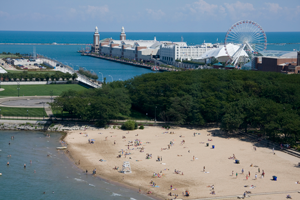Climate Adaptation – Recreational Water and Health

EPA supports local and state efforts to protect and to clean recreational waters. Local water programs are supported by monitoring and notification for recreational waters such as lakes and beaches. The quality of recreational waters may be impacted by changes in the environment.
An increase in the frequency and intensity of storms and floods may cause more runoff of animal waste and other pollutants into recreational bodies. Overflows from sewage systems and treatment plants can also contaminate recreational water bodies. Exposures to these contaminants can affect health by causing gastrointestinal distress, respiratory infections, and ear and skin infections.
In addition, more runoff of nutrients from land (e.g. agriculture, fertilized lawns) under some conditions can cause the growth of harmful algal blooms (HABs) in recreational water bodies. Increasing water temperatures can also promote HABs.
HAB events can produce extremely dangerous toxins that can sicken or kill people and animals who are exposed. Toxins from algal blooms may contaminate seafood that may cause food-borne diseases if consumed. Inhaling aerosols contaminated with cyanobacteria or toxins may cause upper respiratory irritation (wheezing, coughing, chest tightness, and shortness of breath).
People who are exposed to HAB toxins may experience a variety of adverse health effects, such as:
- Nausea
- Vomiting
- Diarrhea
- Fever
- Headache
- Eye infections
- Loss of appetite
- Bad taste in mouth
- Respiratory impacts
- Blood in urine or dark urine
- Progression of muscle twitches
- Acute hepatitis and/or jaundice
- Allergic dermatitis (including rash, itching, and blisters)
- For saxitoxin: High doses may lead to progressive muscle paralysis
